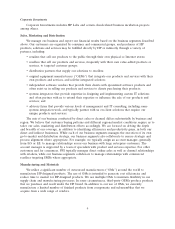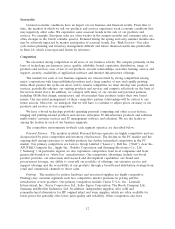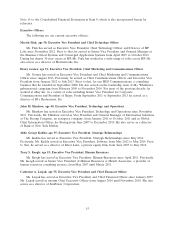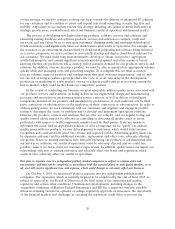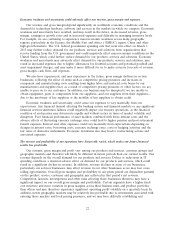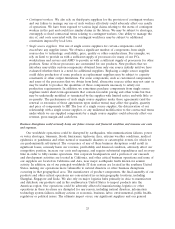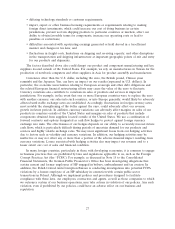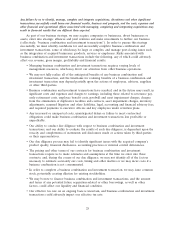HP 2014 Annual Report Download - page 27
Download and view the complete annual report
Please find page 27 of the 2014 HP annual report below. You can navigate through the pages in the report by either clicking on the pages listed below, or by using the keyword search tool below to find specific information within the annual report.security, availability of application software, and internet infrastructure offerings. If our products,
services, support and cost structure do not enable us to compete successfully based on any of those
criteria, our results of operations and prospects could be harmed.
We have a large portfolio of businesses and must allocate resources across all of those businesses
while competing with companies that have much smaller portfolios or specialize in one or more of
these product lines. As a result, we may invest less in certain areas of our businesses than our
competitors do, and these competitors may have greater financial, technical and marketing resources
available to them than our businesses that compete against them. Industry consolidation also may affect
competition by creating larger, more homogeneous and potentially stronger competitors in the markets
in which we compete, and our competitors also may affect our business by entering into exclusive
arrangements with existing or potential customers or suppliers.
Companies with whom we have alliances in some areas may be competitors in other areas. In
addition, companies with whom we have alliances also may acquire or form alliances with our
competitors, which could reduce their business with us. If we are unable to effectively manage these
complicated relationships with alliance partners, our cash flows and results of operations could be
adversely affected.
We face aggressive price competition for our products and services and, as a result, we may have
to continue lowering the prices of many of our products and services to stay competitive, while at the
same time trying to maintain or improve revenue and gross margin. In addition, competitors who have
a greater presence in some of the lower-cost markets in which we compete may be able to offer lower
prices than we are able to offer. Our cash flows, results of operations and financial condition may be
adversely affected by these and other industry-wide pricing pressures.
Because our business model is based on providing innovative and high-quality products, we may
spend a proportionately greater amount on research and development than some of our competitors. If
we cannot proportionately decrease our cost structure on a timely basis in response to competitive price
pressures, our gross margin and, therefore, our profitability could be adversely affected. In addition, if
our pricing and other factors are not sufficiently competitive, or if there is an adverse reaction to our
product decisions, we may lose market share in certain areas, which could adversely affect our revenue
and prospects.
Even if we are able to maintain or increase market share for a particular product, revenue could
decline because the product is in a maturing industry or market segment or contains technology that is
becoming obsolete. For example, our Storage business unit is experiencing the effects of a market
transition towards converged products and solutions, which has led to a decline in demand for our
traditional storage products. In addition, the performance of our Business Critical Systems business unit
has been affected by the decline in demand for UNIX servers and concerns about the development of
new versions of software to support our Itanium-based products. Revenue and margins also could
decline due to increased competition from other types of products. For example, growing demand for
an increasing array of mobile computing devices and the development of cloud-based solutions has
reduced demand for some of our existing hardware products. In addition, refill and remanufactured
alternatives for some of HP’s LaserJet toner and inkjet cartridges compete with our printing supplies
business.
If we cannot successfully execute on our strategy and continue to develop, manufacture and market products,
services and solutions that meet customer requirements for innovation and quality, our revenue and gross
margin may suffer.
Our long-term strategy is focused on leveraging our portfolio of hardware, software and services as
we adapt to a changing and hybrid model of IT delivery and consumption driven by the growing
adoption of cloud computing and increased demand for integrated IT solutions. To successfully execute
19


